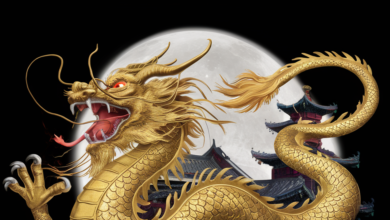
Table of Contents
The Ansai Waist Drum, originating from Ansai District in Yan’an City, Shaanxi Province, stands as one of China’s national intangible cultural heritages. This vibrant, dynamic performance art has a history that stretches back centuries, deeply embedded in the cultural fabric of the Yellow River region. It is renowned for its fierce and robust spirit, reflecting the character of the people from northern Shaanxi. In this expanded exploration, we will delve deeper into its historical roots, artistic features, performance styles, movements, formations, accompaniment, costumes, modern relevance, global recognition, educational programs, community involvement, and its significance in contemporary culture.
Historical Roots
The origins of the Ansai Waist Drum are shrouded in mystery, with no definitive historical records pinpointing its exact beginnings. However, ancient texts like «The Classic of Mountains and Seas» mention the use of drums by the Yellow Emperor in battles against Chiyou. Over time, these drums evolved beyond their military applications to become instruments of morale-boosting and intimidation.
In the early days, especially during periods of conflict and war, the waist drum played a crucial role. It was used to sound alarms during sudden attacks, cheer on soldiers during battles, send distress signals, and celebrate victories. As the military significance of the waist drum waned, it transitioned into a form of folk entertainment, accompanying dances and celebrations.
During the Song Dynasty, the waist drum saw a resurgence as a popular form of folk entertainment. However, it wasn’t until 1942, following Chairman Mao Zedong’s speech at the Yan’an Forum on Literature and Art, that the waist drum truly blossomed. This period saw a cultural renaissance in the Yan’an and Shaanxi-Gansu-Ningxia Border Region, with artists from the Lu Xun Academy of Arts modernizing the costumes and performance styles. The iconic look of white kerchiefs and red belts was established during this time, a look that persists to this day.
In the 1980s, the waist drum began to integrate with other traditional forms like the yangge dance, creating a unique style characterized by bold, vigorous movements. The discovery of Song Dynasty pottery in Zhaoan Township, Ansai County, depicting waist drum performances further attests to the long-standing cultural significance of this art form.

Artistic Features
Over two millennia, the Ansai Waist Drum has developed a distinctive style that is marked by powerful, exuberant, and dynamic movements. Performers exude a sense of intensity, vigor, and fluidity, creating an awe-inspiring visual and auditory experience. The dance is characterized by its rhythmic, fast-paced drumbeats and energetic movements, which often include leaps, spins, and intricate footwork. This blend of rhythm and motion makes the Ansai Waist Drum not just a performance, but a physical manifestation of the region’s cultural vitality.
The choreography of the Ansai Waist Drum is both intricate and demanding, requiring performers to maintain a high level of physical fitness and coordination. The movements are designed to reflect the natural landscapes and the vigorous lifestyles of the people in northern Shaanxi. Every drumbeat resonates with the history and the collective spirit of the community, making each performance a powerful cultural expression.
Performance Styles
The Ansai Waist Drum features roles for both men and women. Male performers are referred to as «kickers» (踢鼓子), while female performers are known as «flower pullers» (拉花), who tie red and green silk ribbons around their waists for a decorative effect. Performances can be highly flexible and adaptable, with group sizes ranging from a few individuals to hundreds or even thousands.
Types of Performances
- Field Drum and Road Drum: Field drum performances are staged in fixed venues like squares or stages, featuring various formations and routines. Road drum performances, also known as «marching drums» or «street drums,» involve performers moving through streets, often during festive events like New Year celebrations, creating a lively and jubilant atmosphere.
- Mountain Drum: Originating from the need to film large-scale productions, mountain drum performances involve hundreds of drummers performing on the ridges of the Loess Plateau, creating a spectacular and grandiose visual effect.
Movements and Formations
The Ansai Waist Drum involves various movements, including small and large waist twirls, horse jumps, and leg kicks. The performances emphasize six key elements: energetic head shakes, vigorous drumstick swings, powerful leg kicks, robust body turns, agile jumps, and full-bodied movements. These elements combine to create a performance that is visually captivating and emotionally stirring.
Traditional formations like «cross plum blossom,» «double row lanterns,» and «nine rings» showcase the creativity and artistic ingenuity of the performers, making each performance a unique visual treat. These formations require precise coordination and teamwork, adding a layer of complexity and beauty to the performances. Each formation is designed to maximize visual impact and showcase the skills of the performers, making the Ansai Waist Drum a mesmerizing spectacle.
Accompaniment and Costumes
The Ansai Waist Drum is accompanied by both percussion and wind instruments. The main percussion instruments include large drums, cymbals, small cymbals, and gongs, with the large drum serving as the primary instrument. Wind instruments, mainly suona horns, add a melodic component to the rhythm, enhancing the overall festive atmosphere.
Performers traditionally wear white headscarves and outfits, symbolizing the energetic and unrestrained spirit of the region. The waist drum itself is a cylindrical instrument tied around the waist with red silk ribbons, and drumsticks adorned with red silk are used to beat the drum. These costumes not only reflect the cultural heritage but also add to the visual appeal of the performances. The vibrant colors and dynamic movements of the costumes contribute to the overall aesthetic, making the performances visually stunning.
Modern Relevance and Global Recognition
In recent years, the Ansai Waist Drum has gained international recognition, with performances held in various countries to promote cultural exchange and understanding. The vibrant and energetic nature of the dance has captivated audiences worldwide, showcasing the rich cultural heritage of China on a global stage. Modern adaptations of the performance, while staying true to traditional elements, have introduced new choreography and styles to appeal to contemporary audiences, ensuring the relevance and continued appreciation of this ancient art form.
This month, a Chinese blogger issued a challenge to break the Guinness World Record for the largest number of people performing the Ansai Waist Drum simultaneously. This event garnered significant attention and highlighted the enduring appeal and cultural significance of the waist drum. Such initiatives not only celebrate the cultural heritage but also bring it into the contemporary spotlight, engaging a broader audience and fostering a deeper appreciation for the art form.
Educational and Cultural Programs
To ensure the longevity of the Ansai Waist Drum, various educational and cultural programs have been established. These programs aim to teach the younger generation about the historical significance and performance techniques of the waist drum. Schools and cultural institutions in the region offer workshops and classes, allowing students to learn and practice the dance. These initiatives play a crucial role in preserving the cultural heritage and fostering a sense of pride and identity among the local community.
The inclusion of the Ansai Waist Drum in school curriculums ensures that the art form is passed down to future generations. By incorporating it into education, students gain an understanding and appreciation of their cultural heritage. These programs often include hands-on training, where students learn the intricate movements and rhythms of the waist drum, providing them with a direct connection to their cultural roots.
Community Involvement
The local community plays a vital role in the preservation and promotion of the Ansai Waist Drum. Festivals and celebrations in northern Shaanxi often feature waist drum performances, bringing together people of all ages to participate and enjoy the vibrant displays. These events strengthen community bonds and ensure that the tradition is passed down through generations. The involvement of the community in these cultural practices underscores the deep-rooted connection between the waist drum and the social fabric of the region.
Community-driven initiatives, such as local festivals and competitions, encourage active participation and help maintain the cultural relevance of the waist drum. These events provide a platform for performers to showcase their skills and for the community to celebrate their shared heritage. The communal aspect of these performances fosters a sense of unity and cultural pride, ensuring the continued practice and appreciation of the Ansai Waist Drum.
Preservation and Impact
Recognized for its vigorous and robust style, the Ansai Waist Drum is celebrated as the «soul drum of the Chinese nation» and the «king of Chinese drums.» As an integral part of Yellow River culture, it embodies the resilience and tenacity of the people from northern Shaanxi. The waist drum’s powerful rhythms and dynamic movements serve as a reminder of the region’s rich cultural history and its enduring spirit.
In 2006, the Ansai Waist Drum was included in the first batch of national intangible cultural heritage lists approved by the State Council of China, ensuring its preservation and continued practice. Efforts to maintain this cultural heritage involve documenting the art form, training new performers, and promoting performances both nationally and internationally. Government and cultural organizations play a crucial role in these preservation efforts, providing resources and support to ensure the continued practice and transmission of the waist drum.
The Future of Ansai Waist Drum
Looking ahead, the future of the Ansai Waist Drum appears promising. With continued efforts to document, teach, and perform this cultural treasure, it is poised to thrive in the modern world. The increasing interest in cultural heritage and the global recognition of the waist drum highlight its significance as a symbol of China’s rich cultural history. As new generations embrace and innovate within this tradition, the Ansai Waist Drum will continue to inspire and captivate audiences around the world.
The adaptability and resilience of the Ansai Waist Drum ensure its relevance in contemporary society. By integrating modern elements while preserving traditional aspects, performers and cultural advocates can engage a wider audience and sustain the art form for future generations. The ongoing efforts to promote and celebrate the Ansai Waist Drum, both within China and internationally, underscore its cultural importance and ensure its continued vitality.
Conclusion
The Ansai Waist Drum is more than just a dance; it is a vibrant expression of cultural identity and historical continuity. Its powerful rhythms and dynamic movements capture the essence of the Yellow River’s cultural legacy, offering a window into the enduring spirit of the people from northern Shaanxi. Through continued preservation and promotion, the Ansai Waist Drum remains a living testament to China’s rich and diverse cultural heritage.
Historical Significance
The Ansai Waist Drum is not merely a form of entertainment; it has played various roles throughout history, from military applications to morale boosting in times of conflict. Its transformation from a military signal to a form of cultural expression is a testament to the adaptability and enduring nature of the art form. This historical journey highlights the importance of the waist drum in the daily lives and cultural practices of the people from northern Shaanxi.
Modern Adaptations and Global Recognition
In recent years, the Ansai Waist Drum has gained international recognition, with performances held in various countries to promote cultural exchange and understanding. The vibrant and energetic nature of the dance has captivated audiences worldwide, showcasing the rich cultural heritage of China on a global stage. Modern adaptations of the performance, while staying true to traditional elements, have introduced new choreography and styles to appeal to contemporary audiences, ensuring the relevance and continued appreciation of this ancient art form.
Educational and Cultural Programs
To ensure the longevity of the Ansai Waist Drum, various educational and cultural programs have been established. These programs aim to teach the younger generation about the historical significance and performance techniques of the waist drum. Schools and cultural institutions in the region offer workshops and classes, allowing students to learn and practice the dance. These initiatives play a crucial role in preserving the cultural heritage and fostering a sense of pride and identity among the local community.
The inclusion of the Ansai Waist Drum in school curriculums ensures that the art form is passed down to future generations. By incorporating it into education, students gain an understanding and appreciation of their cultural heritage. These programs often include hands-on training, where students learn the intricate movements and rhythms of the waist drum, providing them with a direct connection to their cultural roots.
Community Involvement
The local community plays a vital role in the preservation and promotion of the Ansai Waist Drum. Festivals and celebrations in northern Shaanxi often feature waist drum performances, bringing together people of all ages to participate and enjoy the vibrant displays. These events strengthen community bonds and ensure that the tradition is passed down through generations. The involvement of the community in these cultural practices underscores the deep-rooted connection between the waist drum and the social fabric of the region.
Community-driven initiatives, such as local festivals and competitions, encourage active participation and help maintain the cultural relevance of the waist drum. These events provide a platform for performers to showcase their skills and for the community to celebrate their shared heritage. The communal aspect of these performances fosters a sense of unity and cultural pride, ensuring the continued practice and appreciation of the Ansai Waist Drum.
Conclusion
The Ansai Waist Drum is a powerful embodiment of cultural heritage, history, and community spirit. Its vibrant performances, rich historical background, and dynamic movements make it a unique and invaluable part of China’s intangible cultural heritage. Through ongoing preservation efforts and global recognition, the Ansai Waist Drum will continue to resonate with audiences, ensuring that this ancient art form remains a living and thriving cultural treasure


